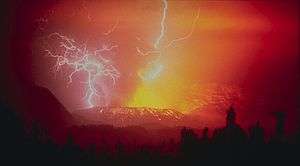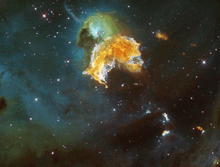List of natural phenomena

A natural phenomenon is an observable event which is not man-made. Examples include: sunrise, weather, fog, thunder, tornadoes; biological processes, decomposition, germination; physical processes, wave propagation, erosion; tidal flow, and natural disasters such as electromagnetic pulses, volcanic eruptions, and earthquakes.[1][2]
Exposure to forces of nature resulted in about 214,000 deaths in 2010, up from 31,000 in 1990.[3]
Types of natural phenomena include, but are not limited to, the following.
Biological

- Decomposition – by which organic substances are broken down into a much simpler form of matter
- Metabolism
- Catabolism
- Anabolism
- Fermentation – converts sugar to acids, gases and/or alcohol.
- Growth
- Population growth
- Overpopulation growth beyond
Chemical

Geological

Geological processes include erosion, sedimentation, and volcanic activities such as geysers and earthquakes.
Meteorological
Violent Meteorological phenomena are called storms. Regular, cyclical phenomena include seasons and atmospheric circulation. Climate change is often semi-regular.

 A tornado on May 3, 1999 in central Oklahoma
A tornado on May 3, 1999 in central Oklahoma
Atmospheric optical phenomena


|
not to be confused with the single "monochrome rainbow" |
Nuclear and Electrical
- Elementary particle interactions
- Supernova
 Liquid hydrogen bubble chamber photograph of an anti-proton colliding with a proton
Liquid hydrogen bubble chamber photograph of an anti-proton colliding with a proton.jpg) Children notice an effect of static electricity
Children notice an effect of static electricity Supernova
Supernova
Oceanographic

- Oceanographic phenomena include tsunamis, ocean currents and breaking waves.
Physical
See also
- Act of God
- Electrical phenomena
- Life timeline
- Materialism
- Midnight sun
- Natural environment
- Nature
- Nature timeline
- Transient lunar phenomenon
References
| Wikimedia Commons has media related to Natural phenomena. |
- ↑ Missy Allen; Michel Peissel (1993). Dangerous natural phenomena. Chelsea House. ISBN 079101794X.
- ↑ William R. Corliss (1977). Handbook of unusual natural phenomena. Sourcebook Project. ISBN 0915554011.
- ↑ Rafael Lozano; et al. (December 15, 2012). "Global and regional mortality from 235 causes of death for 20 age groups in 1990 and 2010: a systematic analysis for the Global Burden of Disease Study 2010". Lancet. 380 (9859): 2095–128. doi:10.1016/S0140-6736(12)61728-0. PMID 23245604.